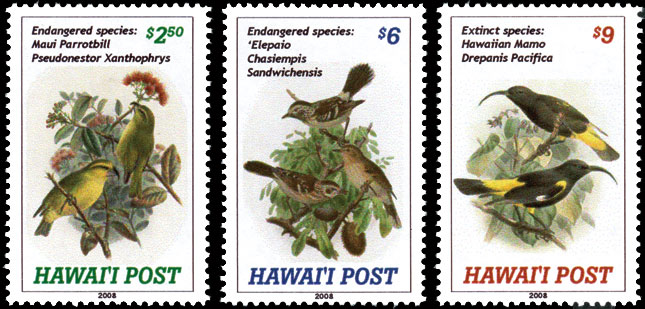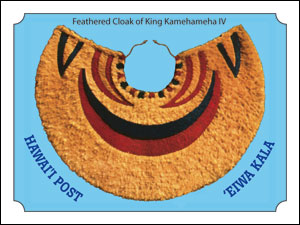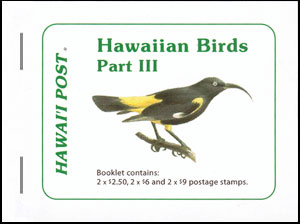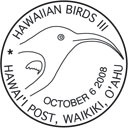.
.
.
.
.
.
.
.
.
.
.
.
.
.
.
.
.
.
.
.
.
.
.
.
.
.
.
.
.
.
.
.
.
.
.
.
.
.
.
.
.
.
.
.
.
.
.
.
.
.
.
.
.
.
.
.
.
.
.
.
.
.
.
.
.
.
.
.
.
.
.
.
.
.
October 6 2008 - Hawaiian Birds, Part III.
Three stamps and a mini-sheet were issued on October 6th 2008 depicting Hawaiian Birds. This is the third in the series of Hawaiian birds. The first issue was released on April 16th 2002 and the second issue on October 10 2003.

The $2.50 stamp (above left) pays for extra charges, such as additional weight. It shows the endangered species Pseudonestor Xanthophrys, known as the Maui Parrotbill, part of the Fringillidae family. It is endemic to the island of Maui and mainly lives in the high elevations of the Ohia Forest on East Maui, which has a high rainfall and cooler temperatures. It has a parrot-like beak and is greenish in color with a yellow belly. It likes to feed on termites and other bugs in trees, and its strong beak allows it to get inside the bark. As with other Hawaiian birds, the encroachment of man on the bird's natural habitat has made it scarcer to find. It has been estimated that currently there are approximately 500 Maui Parrotbills in existence today. It was listed as an endangered species in 1967. There is a captive breeding program which successfully breeds the birds and then realeases them into the wild.
The $6 stamp (above middle) prepays the Overnight rate. It shows the endangered species Chasiempis Sandwichensis, the Hawaiian name is 'Elepaio, derived from the way the bird sings it song. It is a small brown bird up to 5 inches long and is found on the Big Island, Kaua'i and O'ahu, but not on Maui. They feed almost exclusively on insects and spiders. They were highly valued by early Hawaiian canoe builders. When looking for a suitable koa tree to build out of which to build a canoe, they would observe the 'Elepaio. If it spent too much time foraging for insects on one particular tree, the canoe builders knew it was insect-ridden, unsuitable for them and moved on to the next tree. They are endangered because of loss of habitat, diseases, and also introduced predators.
The $9 stamp (above right) prepays the Same Day rate. It shows the extinct species Drepanis Pacifica, known as the Hawaiian Mamo. It was endemic to Hawai'i. This bird lived in the forest canopy and fed on the nectar of lobelia flowers. It needed the long beak to get inside the tall tubular flowers. The Hawaiian Mamo became extinct due to loss of its natural habitat, but mostly because of overhunting. The bright yellow feathers of the Hawaiian Mamo were collected by early Hawaiians to make the feather cloaks worn by Hawaiian Royalty. For example, the golden cloak of Kamehameha I is estimated to contain the yellow feathers of 80,000 Hawaiian Mamos. They were also killed and stuffed and then sold to European collectors. Clearly its attractive yellow feathers led to its extinction by man. The last reported sighting was in 1899.

The $9 minisheet (above) shows a feathered cloak which once belonged to King Kamehameha IV. Feathers were taken from thousands and thousands of the Hawiian Mamo and other native birds just to make this one cloak. This cloak survives today and is on display at the Bishop Museum, Honolulu. 'Eiwa Kala means nine dollars in Hawaiian.

A Booklet was issued consisting of 3 booklet panes. Each pane consists of 2 stamps and has a white margin all around. "Hawai'i Security Printers, Honolulu, Hawai'i" is printed horizontally on the bottom margin and "© 2008 Hawai'i Post" is printed vertically on the lower right side margin of each pane. The Booklet cover shows the extinct Hawaiian Mamo (Drepanis Pacifica).

The postmark for this issue (above) shows the head and long beak of the extinct bird Drepanis Pacifica (shown on the $9 stamp).
The stamps are based on illustrations in Baron Rothschild's two-volume book "The Avifauna of Laysan. Complete history to date of the birds of the Hawaiian Possessions" published in 1893.
WE ACCEPT CREDIT CARDS ON ALL ORDERS
![]()
![]()
![]()
![]()
Technical details of the stamps:
Colors: $2.50, $6 and $9 stamps - Multicolored
Size: 32mm x 48mm (stamps).
Stamps sheet size: 30 ($2.50, $6 & $9 stamps - 6 across, 5 down)
Mini-sheet size: 76mm x 57mm.
Perforation: 12, mini-sheet imperf.
Stamps design: Enelani.
Layout & Pre-press: Enelani.
Printer: Hawai'i Security Printers, Honolulu, Hawai'i.
Printing Method: 4-color CMYK (Cyan, Magenta, Yellow and Black) printing process.
Sheet margin markings: HAWAI'I POST (top middle), "Traffic Light" showing 4 colors used in printing (lower left side), © 2008 Hawai'i Post (lower right side) & Hawai'i Security Printers, Honolulu, Hawai'i. (bottom middle)
Paper: GPA coated white stock with water-activated gum on the back.
Return to list of stamp issues
For details on upcoming stamp issues click here